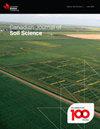Ex situ soil respiration assessment using minimally disturbed microcosms and dried–sieved soils; comparison of methods to assess soil health
IF 1.5
4区 农林科学
Q4 SOIL SCIENCE
引用次数: 1
Abstract
Abstract Soil respiration measurements are commonly used as soil health indicators. Several ex situ soil respiration methods exist, but comparative performances between them have rarely been analyzed. Specifically, there is a lack of comparisons between intact microcosms and destructive methods. The objective of this study was to analyze and compare three different ex situ soil respiration methodologies: minimally disturbed microcosms using fresh soil, dried–sieved 24 h burst test, and dried–sieved 10-day incubation. We hypothesized that (i) the respiration rates for the three methods are correlated to each other; (ii) the respiration rates are strongly correlated with soil physico-chemical parameters; (iii) disturbance caused by drying and sieving reduces regression coefficients compared with microcosms; and (iv) drying and sieving soil produces larger respiration rates. Soil was collected in the Province of New Brunswick, Canada. Total carbon and nitrogen (C:N), pH, aggregate stability, total dissolved C and N, NO3 and NH4, texture, and labile C were determined prior to incubations. Our results showed that the three methods had CO2 efflux in similar ranges. However, all the methods had low to no significant correlations between soil physico-chemical parameters and respiration. Total dissolved N had the strongest correlation with CO2 efflux. The results of the microcosm method significantly correlated with the results for 24 h burst test but not with the 10-day incubation method. We conclude that drying and sieving soil prior to performing ex situ soil heterotrophic respiration measurements using the 24 h burst tests can produce cautiously reliable results. Despite the disturbance, results from the 24 h burst tests are comparable with the results of the microcosm method.利用最小扰动微环境和干筛土壤评估迁地土壤呼吸;土壤健康评价方法的比较
摘要土壤呼吸测量通常被用作土壤健康指标。存在几种迁地土壤呼吸方法,但很少分析它们之间的比较性能。具体而言,完整的微观世界和破坏性的方法之间缺乏比较。本研究的目的是分析和比较三种不同的非原位土壤呼吸方法:使用新鲜土壤的最小扰动微宇宙、24小时干燥-筛分爆裂试验和10天干燥-筛分孵化。我们假设(i)这三种方法的呼吸速率是相互关联的;(ii)呼吸速率与土壤物理化学参数密切相关;(iii)与微观世界相比,干燥和筛分引起的扰动降低了回归系数;以及(iv)干燥和筛分土壤产生更大的呼吸速率。土壤采集于加拿大新不伦瑞克省。在孵育之前测定总碳和氮(C:N)、pH、聚集体稳定性、总溶解的C和N、NO3和NH4、质地和不稳定的C。我们的结果表明,这三种方法的CO2流出范围相似。然而,所有方法的土壤理化参数与呼吸之间的相关性都很低,甚至没有显著相关性。总溶解氮与CO2排放的相关性最强。微宇宙法的结果与24小时爆裂试验的结果显著相关,但与10天孵育法的结果不相关。我们得出的结论是,在使用24小时爆裂试验进行非原位土壤异养呼吸测量之前,对土壤进行干燥和筛选可以产生谨慎可靠的结果。尽管存在扰动,24小时爆破试验的结果与微观方法的结果相当。
本文章由计算机程序翻译,如有差异,请以英文原文为准。
求助全文
约1分钟内获得全文
求助全文
来源期刊

Canadian Journal of Soil Science
农林科学-土壤科学
CiteScore
2.90
自引率
11.80%
发文量
73
审稿时长
6.0 months
期刊介绍:
The Canadian Journal of Soil Science is an international peer-reviewed journal published in cooperation with the Canadian Society of Soil Science. The journal publishes original research on the use, management, structure and development of soils and draws from the disciplines of soil science, agrometeorology, ecology, agricultural engineering, environmental science, hydrology, forestry, geology, geography and climatology. Research is published in a number of topic sections including: agrometeorology; ecology, biological processes and plant interactions; composition and chemical processes; physical processes and interfaces; genesis, landscape processes and relationships; contamination and environmental stewardship; and management for agricultural, forestry and urban uses.
 求助内容:
求助内容: 应助结果提醒方式:
应助结果提醒方式:


